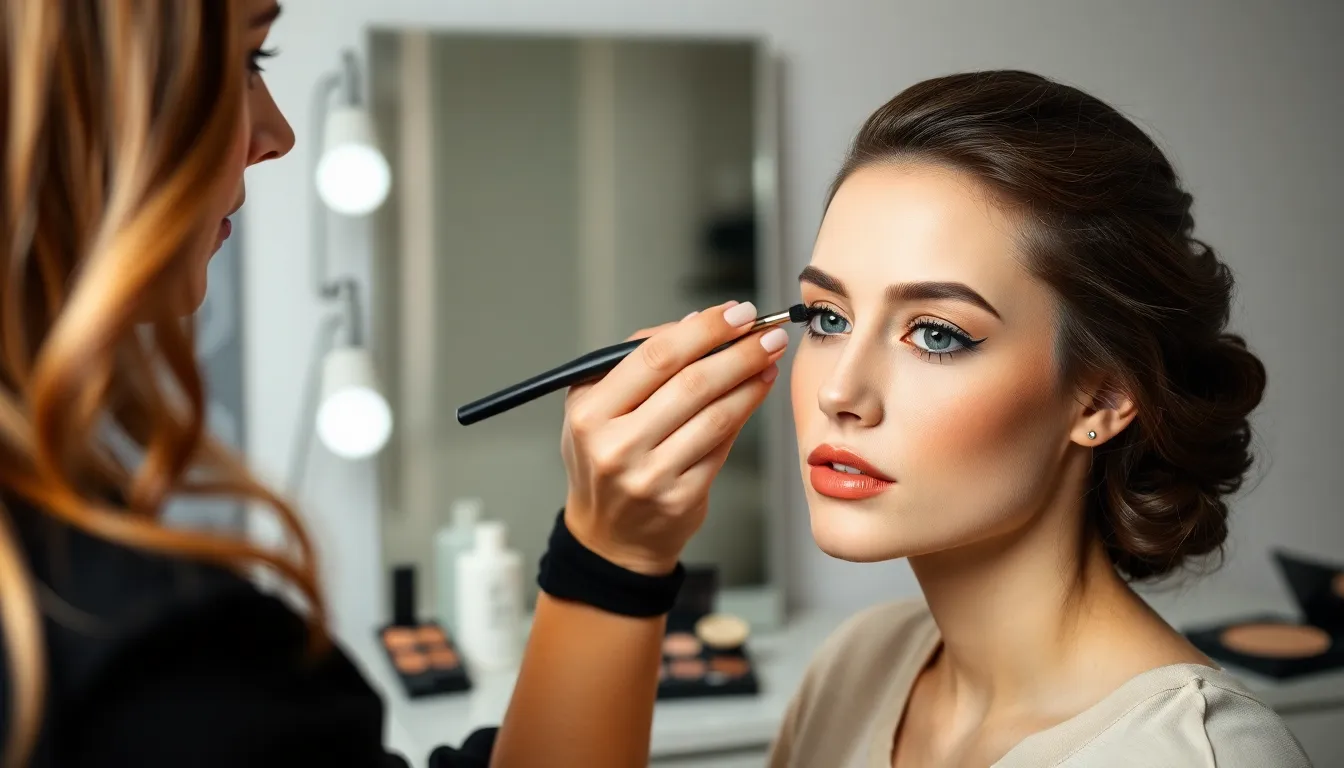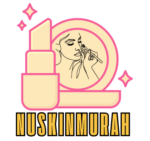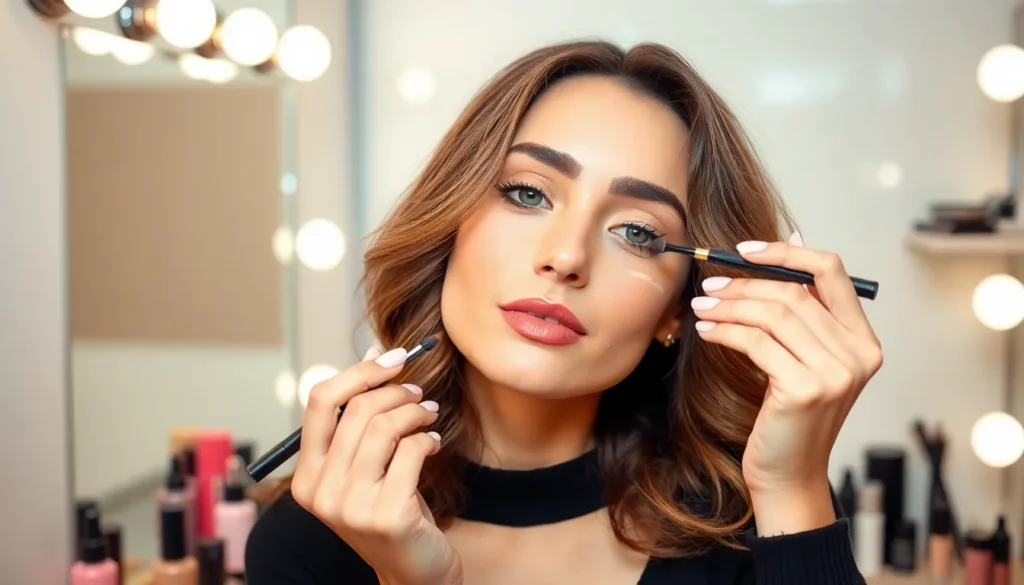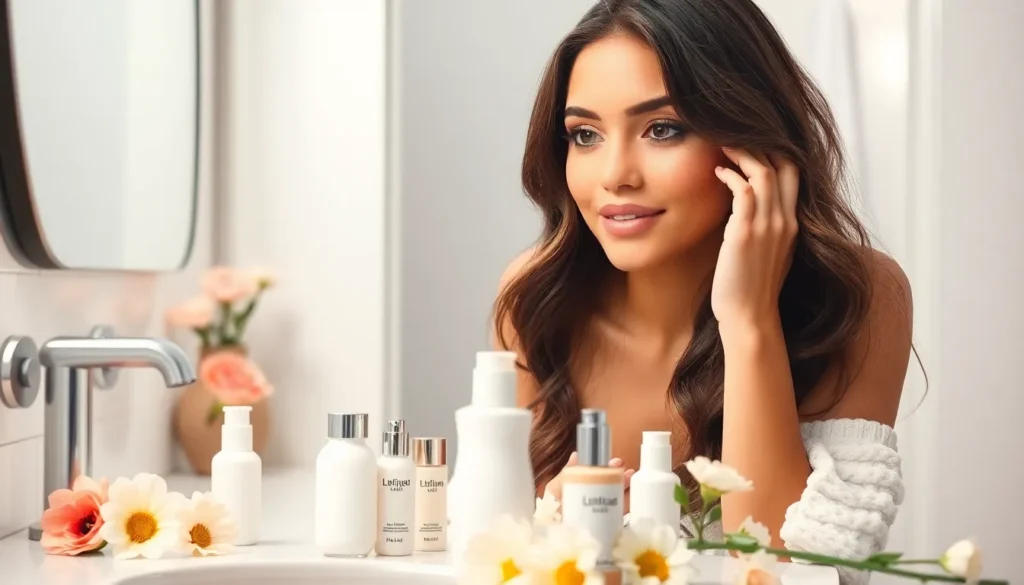Contouring makeup products are like magic wands for your face, transforming an ordinary look into a stunning masterpiece. Who wouldn’t want cheekbones that could cut glass or a jawline so sharp it could slice through the competition? With the right contouring tools, anyone can sculpt their features and unleash their inner glam goddess.
Contouring Makeup Products
Contouring makeup products enable individuals to sculpt and define their facial features. Creams, powders, and sticks serve as common types of contouring products. Each type offers different application methods and finishes, allowing for versatile looks.
Cream contour products blend well into the skin, providing a natural finish. Powders offer buildable coverage, ideal for a more pronounced effect. Stick formulas allow for precise application, making it easy to target specific areas.
Highlighter products complement contouring products by adding brightness and dimension to cheekbones, brow bones, and the nose. Often, highlighters come in liquid, cream, and powder forms. Selecting the right highlighter enhances the overall look.
The right tools play a crucial role in applying contouring products effectively. Brushes, sponges, and makeup applicators help achieve seamless blending. Using a damp sponge often eases the blending process, creating a flawless finish.
Color choice impacts the effectiveness of contouring. Shades that are two to three tones darker than the skin tone serve as ideal contour colors. Highlighter shades should range from soft champagne to icy pearl, depending on skin undertones.
Understanding face shapes assists in determining where to apply contouring products. Heart-shaped faces benefit from contouring at the chin and forehead. Oval faces often require contouring along the jawline and cheeks for added definition.
Ultimately, contouring makeup products offer a range of options for enhancing facial features, ensuring a polished and glamorous appearance.
Types of Contouring Makeup Products

Contouring makeup products come in various forms, each offering unique benefits for enhancing facial features.
Cream vs. Powder Contours
Cream contours provide a dewy finish, ideal for achieving a natural, skin-like appearance. They blend effortlessly, making them suitable for those new to contouring. Users can apply cream formulas with a brush or sponge for smooth results. Powder contours, on the other hand, deliver a matte finish and allow for buildable coverage. These work well for oilier skin types or those seeking a more dramatic look. Choosing between creams and powders largely depends on personal preference and desired looks.
Liquid Contouring Formulas
Liquid contouring formulas offer a lightweight alternative with a sheer finish. Easy to apply, they glide on the skin and can be layered for added intensity. Users can blend liquids with fingers, sponges, or brushes, enabling precise application for targeted areas. Their versatility makes them great for both day and night looks. Liquid contours often hydrate, ensuring a fresh appearance throughout the day.
How to Choose the Right Contouring Makeup Products
Choosing the right contouring makeup products involves understanding individual features, skin tones, and finishes. Several factors influence the selection process.
Skin Tone Considerations
Skin tone determines the best contour shades. For effective contouring, individuals should opt for shades two to three tones darker than their natural complexion. Warm undertones benefit from golden or bronze hues, while cool undertones pair well with taupe or ash colors. Neutral tones can experiment with both families. Individuals can enhance their looks by selecting highlighters that resonate with their undertones. Matching products ensures a harmonious finish that elevates facial features.
Product Formulation Preferences
Product formulation greatly influences application methods and desired effects. Creams provide a natural and dewy finish, ideal for dry skin types. Powders offer a matte finish, perfect for oilier skin. Stick contours enable precision, ideal for on-the-go touch-ups. Liquid formulations allow for layerable coverage, offering adaptability for various occasions. Selecting a product type that aligns with skin type and personal preferences ensures optimal results in achieving defined and sculpted features.
Application Techniques for Contouring Makeup
Achieving flawless contouring requires the right application techniques. Understanding these methods ensures a sculpted, defined look.
Tools for Effective Application
Using the right tools enhances contouring results significantly. Brushes designed for contouring typically feature angled bristles, making them perfect for precise application on the cheekbones and jawline. Sponges provide seamless blending, especially when using cream or liquid contours. Flat brushes work well for applying product along the nose, creating a narrow appearance. Additionally, makeup artists recommend using fan brushes for highlighting, delivering subtle luminosity to cheekbones and temples. Each tool serves its purpose, ensuring contours blend beautifully into the skin.
Step-by-Step Contouring Guide
Following a systematic approach simplifies contouring application. Start with clean, moisturized skin to prepare the canvas. Apply foundation, ensuring an even base for contour products. Next, select a contour shade two to three tones darker than the skin. Use your chosen tool to apply product beneath the cheekbones, along the jawline, and on the sides of the nose. Blend thoroughly to avoid harsh lines. Afterward, highlight key areas such as the tops of the cheekbones and the bridge of the nose using a lighter shade. Finish with setting powder to lock in the look. Each step contributes to a polished, sculpted appearance.
Popular Contouring Makeup Products on the Market
Various contouring makeup products enhance facial features effectively. Cream contours often blend seamlessly, providing a natural finish. Among the options, products like NARS Radiant Creamy Concealer exemplify this category, known for its hydrating formula and impressive coverage.
Powder contours offer buildable coverage that creates a soft, matte finish. Brands such as Too Faced Chocolate Soleil Bronzer stand out for their blendability and long-lasting wear, making them ideal for oily skin types.
Stick contour formulas allow for precise application, ideal for sculpting and defining. Fenty Beauty Match Stix Matte Skinstick showcases this versatility with a creamy texture that glides on effortlessly.
Liquid contour products, which provide lightweight coverage, are also popular. The Benefit Cosmetics Hoola Quickie Contour Stick delivers a sheer and layerable finish, ensuring customization based on desired intensity.
Highlighters play a critical role in contouring routines, adding dimension to the face. Options like Becca Shimmering Skin Perfector highlight notable areas, providing a luminous glow.
Select contour shades carefully based on skin tone and undertones. For instance, shades two to three tones darker than natural skin tones work best for contouring. Warm undertones often pair well with golden hues, while taupe complements cool undertones effectively.
The right tools enhance application and blending techniques. Angled brushes facilitate precise application, while makeup sponges ensure flawless blending. Understanding these various products and their unique benefits enables achieving sculpted features naturally and effortlessly.
Recognizing the significance of color choice and application methods paves the way for stunning results.
Conclusion
Contouring makeup products are essential tools for anyone looking to enhance their natural beauty. With a variety of formulas available from creams to powders and sticks, there’s something for every skin type and preference. The right application techniques paired with suitable tools can elevate any makeup look from ordinary to extraordinary.
Choosing the right shades based on skin tone and undertones is crucial for achieving a seamless finish. By understanding individual features and face shapes, anyone can master the art of contouring. With the right products and techniques, sculpted cheekbones and a defined jawline are within reach, making contouring an invaluable addition to any makeup routine.



